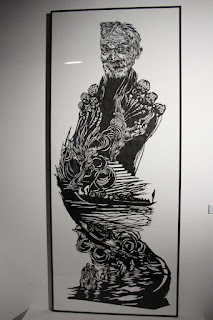 Popular legend has it that this "Kilroy" image was one of the first images of modern graffiti of one self-proclaimed Kilroy which started around 1942 during WWII. A worker, in a Detroit bomb factory started writing "Kilroy was here"on parcels that were left for the front. On the other side, European soldiers who received those packages started writing "Kilroy was here" on the walls that had survived the bombing.
Popular legend has it that this "Kilroy" image was one of the first images of modern graffiti of one self-proclaimed Kilroy which started around 1942 during WWII. A worker, in a Detroit bomb factory started writing "Kilroy was here"on parcels that were left for the front. On the other side, European soldiers who received those packages started writing "Kilroy was here" on the walls that had survived the bombing.
The catalogue of the Street Art exhibition, which is currently on at Musee de la Poste, gives detailed information about the history of Street Art. The dawning days of street art are said to have been between the years 1945 and 1960. By the seventies, in the United States, graffiti tags could be found everywhere from public buildings to the insides of subway cars. Around these years, style, original touches emerged, followed closely by a culture of graffiti artist one-upmanship that fuelled artists to achieve the ultimate goal to create a more colossal and more awe-inspiring piece than the artist before. By the 1980's graffiti artists were being invited to exhibit their work in art galleries as interest in artistic circles grew. These exhibitions enshrined young graffiti 'writers', as they called themselves, as full fledged artists. In the late eighties, the movement moved away from trains and city walls, as artists began experimenting with different mediums. In the United States, particularly New York, as authorities reined in on graffiti, Europe saw a burgeoning movement, similarly in Brazil, Australia and the UK as styles grew more amazing and assertive.
 Between 2000 and 2010, new forms of street art emerged. Stencilling, which became popular in the 80s in France, is one of the more popular street art forms today. Other techniques like fly posting, woodblocking or use of mosaics with strong glue, as Invader does, are equally popular.
Between 2000 and 2010, new forms of street art emerged. Stencilling, which became popular in the 80s in France, is one of the more popular street art forms today. Other techniques like fly posting, woodblocking or use of mosaics with strong glue, as Invader does, are equally popular.
I saw them all under one roof yesterday. It is a small space to fully exhibit the work of eleven street artists, but it still worked well enough. I recognised some of the images, from having seen them around Paris, and the exhibition gives a bio on each artist, with information on the medium they use.
The exhibition is on until March 2013 at Musee de la Poste.
More pictures here.

























No comments:
Post a Comment